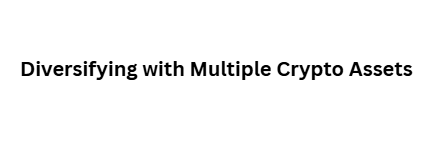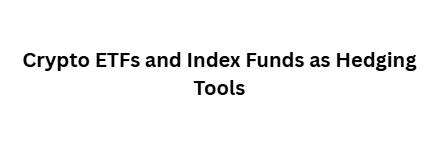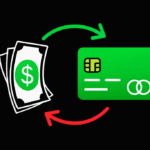This article covers the Advanced Strategies to Hedge Forex Positions Using Crypto Assets. Although the risk is associated with the volatility of the Forex trading market, crypto assets provide a cutting-edge solution to the problem.
Hedging with crypto market assets, from stablecoins and derivatives to algorithmic trading and dynamic rebalancing, allows traders to manage risk, safeguard their capital, and keep their portfolios in Forex and crypto markets balanced and streamlined.
Why Use Crypto Assets for Hedging
High Liquidity and 24/7 Markets
- While the Forex markets have set trading hours, the crypto markets are open all the time.
- This flexibility means traders can open or close hedging positions whenever they need to.
Diversification of Risk
- Crypto assets tend to lack strong correlations with traditional fiat currencies.
- By adding crypto assets to Forex portfolios, traders can sustain risks and volatility during trying times.
Access to Advanced Hedging Tools
- Advanced crypto trading tools, including futures and options and leveraged tokens, provide new ways to hedge.
- These products provide the means to effectively manage Forex exposure through hedging.
Potential for Higher Returns
- The volatility of crypto can work to your favor during hedging as loss mitigation can be converted to profit.
Decentralization and Global Accessibility
- The lack of a governing body and the ability to cross borders gives crypto assets unique and strong hedging capabilities.
- Crypto assets hedge against geopolitical and systematic financial risks and are reliable during crises.
Key Point & Advanced Strategies to Hedge Forex Positions Using Crypto Assets
| Strategy | Key Points / Benefits |
|---|---|
| Using Stablecoins to Offset Forex Exposure | Provides a safe, low-volatility asset to protect against currency swings; preserves value during market turbulence. |
| Crypto-Cross Hedging with Correlated Assets | Uses crypto assets correlated with Forex pairs to offset losses; helps balance risk dynamically. |
| Leveraging Crypto Derivatives (Futures & Options) | Offers precise hedging tools; allows protection against adverse price movements with leverage. |
| Inverse Crypto Pairs for Risk Mitigation | Hedge using crypto pairs moving inversely to Forex positions; minimizes losses during market swings. |
| Diversifying with Multiple Crypto Assets | Reduces risk through portfolio diversification; smoothens volatility exposure. |
| Using Algorithmic Trading for Automated Hedging | Automates hedging decisions; monitors markets 24/7 and executes trades efficiently. |
| Crypto ETFs and Index Funds as Hedging Tools | Provides broad market exposure; reduces single-asset risk while maintaining hedge effectiveness. |
| Cross-Margin Hedging Between Forex and Crypto Accounts | Optimizes capital use; balances risk between multiple accounts and instruments. |
| Implementing Stop-Loss and Take-Profit in Crypto Hedging | Automates risk management; protects positions from extreme losses and locks in gains. |
| Dynamic Rebalancing of Forex and Crypto Portfolio | Adjusts portfolio regularly to maintain hedge effectiveness; responds to market changes and correlations. |
1. Using Stablecoins to Offset Forex Exposure
Assets such as USDT, USDC, and BUSD stablecoins present traders with low-volatility options to hedge Forex positions. Even during sudden shifts in the value of a Forex currency, traders can convert a portion of the exposed currency into stablecoins, thus safeguarding the value of their Forex positions.

The method outlined in Advanced Strategies to Hedge Forex Positions Using Crypto Assets is risk averse and preserves liquidity, offering the trader the option of a quick withdrawal during hedging. Stablecoins provide excellent capital preservation during market volatility with predictable risk and no exposure to cryptos’ erratic pricing.
Using Stablecoins to Offset Forex Exposure Features
- Low Volatility: Stablecoins offer a fixed value which mitigates risk from unanticipated Forex fluctuations.
- Liquidity: Forex exposure is tabble and can be unexposed at any point.
- Capital Population: Forex positions can be safeguarded when the market become hyper volatile.
2. Crypto-Cross Hedging with Correlated Assets
Defining the strategy allows traders to select cryptocurrencies with historical correlation with Forex pairs. After correlation and trend analysis, a trader can potentially gain on a crypto correlated to offset losses on the Forex position.

JDS Technologies states that this allows a trader to pivot to dynamic risk control and remain exposure to profitable correlated opportunities.
A level of control with correlation risk is important and wrong correlation risk and analysis can do the opposite and increase risk.Cross hedging incorporates flexibility and potentially integrates other resources to create optimized hedging portfolios.
Crypto-Cross Hedging with Correlated Assets Features
- Correlation-Based Protection: Losses in Forex positions can be protected by choosing crypto assets that are Forex pair correlated.
- Dynamic Risk Management: Correlations alterations over time are predictable and can be used to adjust your hedges.
- Profit Opportunities: Forex positions can take small losses while crypto provide gains.
3. Leveraging Crypto Derivatives (Futures & Options)
Along with other crypto derivatives, futures and options are useful for hedging Forex positions. Position traders can mitigate risk against adverse market moves by locking in a specified price or gaining the right to buy or sell an asset.

Advanced Strategies to Hedge Forex Position Using Crypto Assets cites the flexible timing derivatives afford and risk exposure as key metrics in employing advanced strategies to manage crypto assets.
Using futures contracts enables traders to implement either a long or short hedge, while options allow the hedger to limit losses to the loss of a premium. Traders are likely to use derivatives to manage volatility, protect profits, and adjust their hedges dynamically as market conditions change, all of which demonstrate managed flexibility in their positions relative to the market.
Leveraging Crypto Derivatives (Futures & Options) Features
- Price Locking: Protect market movements with Crypto assets by locking position via derivatives.
- Flexibility: Hedging on Forex can use derivatives for short or long positions depending on the desired exposure.
- Controlled Risk: Risk is kept under control with options by limiting it to any lost premium.
4. Inverse Crypto Pairs for Risk Mitigation
Cryptocurrency pairs that are inversely correlated will, in conjunction with your other Forex positions, allow for loss offsetting. A crypto asset, selected for its inverse correlation, will appreciate in value when a Forex position is losing value, thereby preserving the balance of a portfolio.

Advanced Strategies to Hedge Forex Positions Using Crypto Assets indicates that pairs are useful when volatility spikes or during market reversals.
Traders need to continuously assess correlations to market trends to make sure they remain effective. These strategies improve capital preservation while exposure to protective market movements is retained.
Inverse Crypto Pairs for Risk Mitigation Features
- Opposite Movement: Forex positions can be hedged with crypto assets that move inversely or oppositely.
- Loss Reduction: Provides buffering on market downturns and offsets losing during such times.
- Strategic Balancing: Improves overall portfolio stability against sharp increases in volatility.
5. Diversifying with Multiple Crypto Assets
This is because reliance on the performance of any one crypto asset will not be too focused on. By allocating hedge positions to various cryptos, individual asset volatility on Forex exposure will be less impactful.

Advanced Strategies to Hedge Forex Positions Using Crypto Assets reinforce the idea that unifying poorly correlated assets will yield smoother returns, thereby, reducing the portfolio risk.
There is also the factor of being able to split focus on multiple markets, which increases the efficiency of hedging. Risk and Flexibility will be optimized with a mix of stable coins, major crypto, and high potential altcoins. These include the ability to pivot under different market conditions of Forex and crypto.
Diversifying with Multiple Crypto Assets Features
- Risk Reduction: Limits the potential loss to the portfolio on any single cryptocurrency.
- Smoother Performance: Lessens the impact of any one asset’s volatility on the overall portfolio.
- Optimized Hedging: Trade-off different assets in a portfolio to maximize the potential benefits.
6. Using Algorithmic Trading for Automated Hedging
With algorithmic trading, designed computer systems automate the Forex and crypto position hedging systems. These systems will maintain capital preservation and consistent risk management, market conditions will govern trade execution and offset hedging adjustments will be real-time.

Automated systems improve market efficiency with less emotional decision making and crossing the assessment will be risk execution especially under highly volatile conditions. Advanced Strategies to Hedge Forex Positions Using Crypto Assets illustrates the value of such systems.
Creating strategies for stop-loss, take-profit, and dynamic rebalancing enables traders to intertwine speed and accuracy. Algorithmic hedging continually monitors and adjusts to opportune moments for adjustments in a way that human traders would miss. This enhances portfolio caps and saves traders from missing sudden swings in the market.
Using Algorithmic Trading for Automated Hedging Features
- Continuous Operation: Engages in constant monitoring of the crypto market in real-time.
- Absence of Emotional Bias: Automated trading eliminates the possibility of emotional trading.
- Market Efficiency: Automated trading adjusts to market movements real-time.
7. Crypto ETFs and Index Funds as Hedging Tools
Without the need to administer individual assets, crypto ETFs and index funds provide traders with varied exposure to the larger crypto market. To mitigate systemic risk on sprawling crypto assets, traders can allocate a piece of their Forex exposure to these funds.

The ETFs and indices approach described in Advanced Strategies to Hedge Forex Positions Using Crypto Assets minimizes reliance on single assets while preserving flexibility in the overall portfolio.
Compared to a coin collection, segmented coins become cumbersome to manage and control to the extent that it spurs the need for risk management. This way, traders can withstand severe changes in the market and capitalize on the gains in the crypto market. This provides traders with a less volatile approach to hedging.
Crypto ETFs and Index Funds as Hedging Tools Features
- Broadened Risk Exposure: Instantly encapsulates asset allocation across in multiple crypto assets.
- Mitigated Single Asset Risk: Absorbs losses from one coin through several others.
- Flexibility for the Portfolio: Rebalancing a portfolio to maintain the hedge becomes less complicated.
8. Cross-Margin Hedging Between Forex and Crypto Accounts
By permitting margin from one account (Forex or crypto) to manage risk in the other, cross-margin hedging provides risk reduction by allocating more margin to one side of the account. This enhances efficiency in capital use.
The Advanced Strategies to Hedge Forex Positions Using Crypto Assets points out that this method enables traders to handle numerous hedging positions without over committing funds. By intelligently using collateral, traders are able to handle risk, balance exposures, and defend against unanticipated shifts in the market.

Because of the inherent nature of cross-margin strategies, there is a risk of over-leverage and rapid sequence margin calls which translates to losses. However, if crafted right, this method provides the most inestimable value in terms of flexibility.
It facilitates the ability to hedge in multiple markets at the same time and optimally utilizes capital to hedge and trade at the same time. The capital, in this sense, is protecting the trader and maximally allowing the trader to exploit market opportunities.
Cross-Margin Hedging Between Forex and Crypto Accounts Features
- Capital Use Efficiency: Enables one account to lock-in margin across multiple accounts.
- Risk Balance: Shifting the exposure aligned with the crypto and Forex positions.
- Hedge Maintenance Efficiency: The capital won’t be idle while the hedge still exists.
9. Implementing Stop-Loss and Take-Profit in Crypto Hedging
Automated Forex risk control is achieved through stop losses and take profit. It outputs loss and profit limits in a range to manage control. It also manages losses in the range and captures the profit range.

Advanced Strategies to Hedge Forex Positions Using Crypto Assets highlighted how this freeds traders from the emotional burden of excessive focus. The automated exclusion of sudden volatility ensures neutral hedging. The interval of profit capture is defined by liquidity. This works efficiently with other hedging tools. It also closes the gap of risk between the Forex and crypto markets.
Implementing Stop-Loss and Take-Profit in Crypto Hedging Features
- Risk Management Automation: Auto hedge a position with defined exit points to reduce loss.
- Escaping Losses: Profit target will release the capital aiding in the trade while the coin is losing value.
- Minimizes Losses: Decreases exposure during abrupt changes in the market.
10. Dynamic Rebalancing of Forex and Crypto Portfolio
Dynamic rebalancing is the adjustment of holdings to again bring them to the desired levels of effectiveness, risk target and range, and management of the hedge.

Advanced strategies to hedge Forex positions using crypto assets show how correlations between assets can change and be adjusted. To optimize hedging results, traders can analyze results and other factors like market trends and volatility to reallocate capital. Their active participation helps prevent one asset from overweighing a position, and their risk exposure is kept proportional to their trading goals.
This proactive means will preserve capital drown in market changes, adjusted within the risk framework to maintain effective Forex and crypto hedging over time. Still, managing variance and concentration within the capital structure will ensure effective repositioning and rebalancing. This will risk exposure to crypto volatility, sustaining long-term hedging efficiency.
Automated Rebalancing of Forex and Crypto Portfolio Features
- Hedge Maintenance: Adjusts positions to optimal risk protection.
- Market Change Response: Adaptability to varying correlations and volatility.
- Stable Portfolio: Balanced exposure and risk control consistency.
Conclusion
Using crypto assets to hedge Forex positions provides traders with new technological solutions to manage their risk. The use of stablecoins, crypto derivatives, algorithmic trading, and dynamic portfolio rebalancing provides strategies to defend against a drawdown while trying to defend a Forex position and optimize the return.
Shielding Forex positions while exploiting the crypto market range enables traders to engage value-added crypto DeFi and hedge crypto positions while optimizing Forex positions and protecting against returns.
FAQ
What does hedging Forex positions with crypto assets mean?
Hedging Forex positions with crypto assets involves using cryptocurrencies, stablecoins, derivatives, or other crypto instruments to reduce the risk of losses from currency fluctuations. It helps balance potential losses in Forex trades by creating offsetting positions in the crypto market.
Which crypto assets are best for hedging Forex positions?
Stablecoins like USDT or USDC are ideal for low-volatility hedges, while major cryptocurrencies such as BTC or ETH can be used for correlated or inverse hedges. ETFs and crypto index funds provide diversified exposure, reducing single-asset risk.
How do crypto derivatives help in Forex hedging?
Crypto derivatives, such as futures and options, allow traders to lock in prices or gain the right to buy/sell at a predetermined price. They provide flexibility, limit potential losses, and enable precise risk management in volatile markets.







